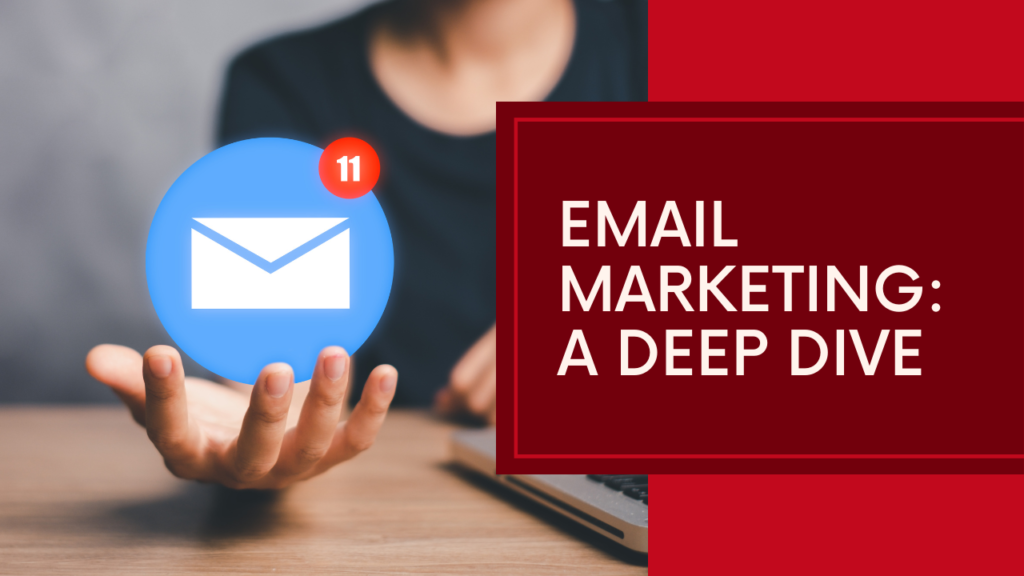Email Marketing: A Deep Dive
Email marketing continues to be one of the most effective ways to reach customers and drive results. When executed properly, it delivers impressive returns, making it an essential component of any modern marketing strategy.
According to Tidio, the average open rate for email marketing is around 19%. Worldwide open rates are highest every Tuesday at about 25%. During Mondays and Wednesdays, the open rates are 22% and 21% respectively. A good open rate for email marketing should range around 19% to 26%, depending on the niche or industry.
As for the click-through rate, the average percentage for email marketing is 2.3%. Other data from Barilliance also shows that the average conversion of email marketing peaked during the year 2021, which is 8.87%.
Building an Email List

The key to successful email marketing is building a high-quality, engaged email list. This starts with capturing the right contacts through website sign-ups and offering incentives or lead magnets in exchange for email addresses. Social media and community outreach can also be leveraged to grow your list, as can list rental or co-marketing partnerships.
However, it’s essential to focus on quality over quantity. A smaller list of highly engaged subscribers will almost always outperform a massive list of disinterested recipients.
Email Content Best Practices
Here are some of the best practices that one must do when doing email marketing.
Personalized subject lines and content
- Use the recipient’s name in the subject line and email content to make it feel more personal and engaging
- Leverage data you have about the subscriber’s interests, behaviors, or demographics to tailor the messaging and offers
- Segment your email list to allow for more targeted content based on factors like location, purchase history, or engagement levels
Layout, design and template considerations
- Use a clean, mobile-responsive design with clear calls-to-action and easy navigation
- Incorporate compelling visuals like images, gifs, or videos to break up text and reinforce your message
- Establish consistent branding through your email templates, using colors, fonts, and styling that align with your website and other marketing channels
- Pay close attention to things like text size, line spacing, and hierarchy to ensure readability across devices
- Test different layouts and designs through A/B testing to optimize for engagement and conversions
Validating content accuracy
- Fact-check any statistics, data points, or claims made in your email content to maintain credibility
- Have a process for careful proofreading and editing to catch spelling and grammar errors
- Ensure all links and CTAs are working properly before sending the email
- Provide accurate and up-to-date information about products, pricing, events, or any other details mentioned
- If citing external sources or quotes, verify the attribution and context to avoid misrepresentation
- Regularly review and update email content to remove outdated information or broken links

Email Automation Tools
Modern email marketing platforms offer powerful automation capabilities that can help streamline campaigns and improve relevance. Sequence-based emails can be used for onboarding new subscribers, re-engaging inactive ones, or delivering educational content over time.
Trigger-based emails can also be set up to respond to specific user actions, such as cart abandonment, product browsing, or content engagement. This allows for highly targeted messaging that speaks to the individual subscriber’s behavior and interests.
Emerging AI capabilities are also being applied to email marketing, with tools for automated copywriting, subject line generation, and content optimization through A/B testing.

Measuring Performance
To assess the effectiveness of email campaigns and continuously improve, it’s crucial to track key performance metrics. Open rates, click-through rates, bounce rates, and unsubscribe rates should all be monitored closely.
Conversion rates and return on investment (ROI) are also critical, as they ultimately determine the bottom-line impact of email marketing efforts. A/B testing can help optimize these metrics by allowing marketers to experiment with different subject lines, content variations, and send times.
Deliverability and Inbox Placement
Even the most compelling email content will fall flat if the messages never make it to the recipient’s inbox. To maximize deliverability, it’s essential to build email lists based on permission and consent, avoiding any tactics that could be perceived as spam.
Implementing email authentication methods like Sender Policy Framework (SPF), DomainKeys Identified Mail (DKIM), and Domain-based Message Authentication, Reporting, and Conformance (DMARC) can also help improve inbox placement and protect against spoofing and phishing.
Regularly monitoring and maintaining a good sender reputation is also crucial, as poor practices like high bounce rates or spam complaints can quickly land messages in the junk folder.
Staying Relevant With Trends
The email marketing landscape is constantly evolving, and businesses must adapt to stay competitive. Trends such as personalized, interactive email experiences and integration with broader marketing automation platforms are becoming increasingly important.
Compliance with privacy regulations like the General Data Protection Regulation (GDPR) and the California Consumer Privacy Act (CCPA) is also a key consideration, as consumers become more aware of their data rights and demand greater transparency from brands.
By embracing these trends and best practices, businesses can continue to leverage email marketing as a powerful tool for customer engagement, driving conversions, and fostering long-term loyalty.

Frequently Asked Questions
What are the 4 types of email marketing?
- Promotional emails: These are the classic marketing emails that promote a product, discount, or event. You subscribe to get updates from your favorite brands. Gotta love those promo codes!
- Relational emails: These build a relationship with the customer through newsletters, welcome series, birthday emails, etc. It’s all about strengthening that brand-customer bond over time.
- Acquisition emails: Used to generate new leads and customers. Things like lead magnet emails with a free download or guide in exchange for an email signup. Great for growing that list!
- Operational emails: More functional emails like order confirmations, password resets, and receipts. It’s not super glamorous, but it’s essential for transactional communication and support.
What is email marketing delivery?
That’s all about getting your message reliably into the inbox and not the dreaded spam folder. Things like proper email authentication, good sender reputation, following anti-spam laws, and getting people to mark you as a safe sender. No spamming allowed!
When should we use email marketing?
Email marketing can be useful in so many situations! It’s great for welcoming new customers, staying top of mind with existing customers, driving repeat purchases, sharing news and updates, building your brand reputation… The list goes on. If you have an audience you want to communicate with directly, email is a powerful channel.
What is email marketing, and why is it important?
Email marketing lets businesses and organizations send messages directly to the inboxes of subscribers who opted in to receive them. It’s important because email has an incredibly high return on investment, helps nurture customer relationships, and gives you direct access to your audience. Plus, over 4 billion people worldwide use email – that’s a huge potential reach!
What are the benefits of email marketing?
The benefits of email marketing include cost-effectiveness, measurable results, high conversion rates, an engaged audience, the ability to segment and personalize messaging, driving website traffic, and building brand awareness and reputation. That’s a pretty great list! No wonder email keeps going strong even with newer marketing channels popping up.

… [Trackback]
[…] Read More to that Topic: shanehummus.com/digital-marketing/email-marketing/ […]
… [Trackback]
[…] Find More Information here to that Topic: shanehummus.com/digital-marketing/email-marketing/ […]
… [Trackback]
[…] Information on that Topic: shanehummus.com/digital-marketing/email-marketing/ […]
… [Trackback]
[…] Find More Information here to that Topic: shanehummus.com/digital-marketing/email-marketing/ […]
… [Trackback]
[…] Info on that Topic: shanehummus.com/digital-marketing/email-marketing/ […]
… [Trackback]
[…] Info on that Topic: shanehummus.com/digital-marketing/email-marketing/ […]
… [Trackback]
[…] Information to that Topic: shanehummus.com/digital-marketing/email-marketing/ […]
… [Trackback]
[…] Find More Info here on that Topic: shanehummus.com/digital-marketing/email-marketing/ […]
… [Trackback]
[…] Find More on that Topic: shanehummus.com/digital-marketing/email-marketing/ […]
… [Trackback]
[…] Find More Information here on that Topic: shanehummus.com/digital-marketing/email-marketing/ […]
… [Trackback]
[…] There you can find 34448 more Information to that Topic: shanehummus.com/digital-marketing/email-marketing/ […]
… [Trackback]
[…] Read More on on that Topic: shanehummus.com/digital-marketing/email-marketing/ […]
… [Trackback]
[…] Read More on that Topic: shanehummus.com/digital-marketing/email-marketing/ […]
… [Trackback]
[…] Information to that Topic: shanehummus.com/digital-marketing/email-marketing/ […]
… [Trackback]
[…] Info to that Topic: shanehummus.com/digital-marketing/email-marketing/ […]
… [Trackback]
[…] Read More on on that Topic: shanehummus.com/digital-marketing/email-marketing/ […]
… [Trackback]
[…] Info on that Topic: shanehummus.com/digital-marketing/email-marketing/ […]
… [Trackback]
[…] Read More Info here on that Topic: shanehummus.com/digital-marketing/email-marketing/ […]
… [Trackback]
[…] Here you will find 78247 additional Information to that Topic: shanehummus.com/digital-marketing/email-marketing/ […]
… [Trackback]
[…] There you can find 66523 more Info on that Topic: shanehummus.com/digital-marketing/email-marketing/ […]
… [Trackback]
[…] Read More Information here to that Topic: shanehummus.com/digital-marketing/email-marketing/ […]
… [Trackback]
[…] Information to that Topic: shanehummus.com/digital-marketing/email-marketing/ […]
… [Trackback]
[…] Read More Info here to that Topic: shanehummus.com/digital-marketing/email-marketing/ […]
… [Trackback]
[…] Read More here on that Topic: shanehummus.com/digital-marketing/email-marketing/ […]
… [Trackback]
[…] Info to that Topic: shanehummus.com/digital-marketing/email-marketing/ […]
… [Trackback]
[…] Read More here to that Topic: shanehummus.com/digital-marketing/email-marketing/ […]
… [Trackback]
[…] Find More to that Topic: shanehummus.com/digital-marketing/email-marketing/ […]
… [Trackback]
[…] Info to that Topic: shanehummus.com/digital-marketing/email-marketing/ […]
… [Trackback]
[…] Read More to that Topic: shanehummus.com/digital-marketing/email-marketing/ […]
… [Trackback]
[…] Read More here to that Topic: shanehummus.com/digital-marketing/email-marketing/ […]